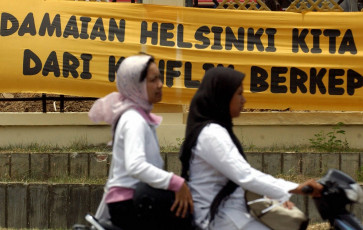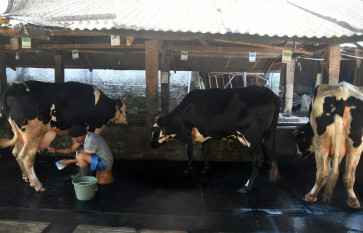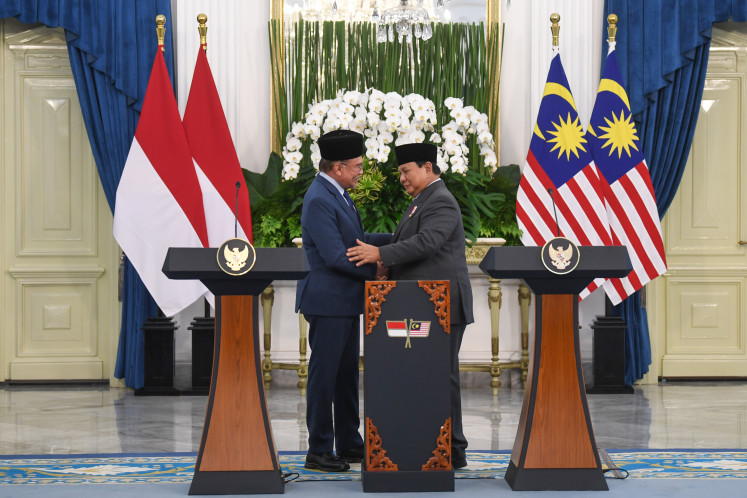Popular Reads
Top Results
Can't find what you're looking for?
View all search resultsPopular Reads
Top Results
Can't find what you're looking for?
View all search resultsOld Peneleh cemetery a forgotten heritage
Since it became defunct in 1955, the condition of the old Peneleh cemetery in Surabaya has deteriorated despite its impressive history, which dates back to its establishment in 1814
Change text size
Gift Premium Articles
to Anyone

S
ince it became defunct in 1955, the condition of the old Peneleh cemetery in Surabaya has deteriorated despite its impressive history, which dates back to its establishment in 1814. It used to be a “sacred” place which only Dutch people had access to, recalled Armuji, 50, a resident.
“When I was a kid there were ghost stories about the cemetery but I guess they were made up to keep away tomb raiders,” he recalled. But now anyone can enter the cemetery: Couples who want to take pre-wedding photographs among the tombs; trash-pickers, children looking for a makeshift soccer fi eld, and even hungry goats. Ten families even live inside the cemetery in wooden huts.
As a result, the marble that once covered the tombs is now either absent or chipped, and the steel handles on the tomb covers are also gone.
JP/Indra Harsaputra
Oldest modern cemetery The cemetery was established in 1814 by a Dutch colonial offi cial named De Begraafplaats Peneleh Soerabaja. It was built much later than the Kebon Jahe Kober cemetery in Jakarta, which was established on Sept. 28, 1795. It was renamed Taman Prasasti Museum in 1977, following its restoration.
However, Peneleh remains the oldest modern cemetery among similar cemeteries in several countries.
Peneleh is older than Fort Cannin Park (1926) in Singapore, Gore Hill Cemetery (1868) in Sydney, La Chaise Cemetery (1803) in Paris, Mount Auburn Cemetery (1831) in Cambridge – which was declared the fi rst modern cemetery of the world – or Arlington National Cemetery (1864) in Washington DC.
The deteriorating condition of Peneleh has been a point of concern in the Netherlands since 2006, after a legatee wrote an article for NRC Handlesbald titled “De geiten en de doden wonen samen” (Being dead with living goats).
The cemetery caretaker Misha said that many people had removed the remains of their relatives to other cemeteries.
“People just don’t want to visit a cemetery that is littered with garbage and smells bad,” he said.
An observer of Surabaya historical sites, Kuncarsono Prasetyo, said that the Dutch government was overwhelmed with the responsibility of managing Dutch cemeteries in Indonesia, whose numbers exceeded the number of cemeteries at home.
“The Dutch government has appointed a foundation to manage war cemeteries, called Erevelden, but it is also open to collaboration with the Indonesian government for conservation and its management,” Kuncarsono said.
From offi cial to priest History records that many important people in the history of Surabaya, the country and even the world were buried in Peneleh cemetery.
One of them is former Governor General Pieter Merkus. Born in March 18, 1787, Merkus was the 47th high offi cial of the Dutch colony. He died in Aug. 2, 1844. His legatee, Rob van de Ven Renardel, stated in Monsun magazine issued on April 10, 1999, in the Netherlands, said that Merkus was moved from Bogor Palace to Simpang Huis Palace (now Grahadi building) in Surabaya after he fell ill.
There was also the grave of Alferd Emile Rambaldo, born in Rembang, Pasuruan, East Java. The scripture on his tomb reads: “Rambaldo is a pioneer of air travel. He found and developed an air transportation device between 1908 and 1911 using a motorized air balloon”.
He started his career as a Navy soldier, but then switched interests to the latest European technology: Flying machines. He later was based in Surabaya, where he built motorized air balloons. He also developed a meteorology observation system and photographed the town from the air.
He died while fl ying an air balloon in Blora, Central Java, when he was 31. For his efforts, the government at that time built a statue of him and placed it in Kroesenpark, now called Apsari Park, in Surabaya. The statue has now gone and is replaced by the statue of former Indonesian Governor Suryo.
Jesuit priest Martinus van den Elsen, Indochina war commander Neubronner van der Tuuk, Porong Bridge architect Ibrahim Simon Heels Berg and Supreme Court deputy chief PJN de Perez were also buried in Peneleh Cemetery.
There was a short-lived initiative to restore and conserve the 4.5-hectare cemetery in 1980, but it seems that the cemetery just has to wait.









